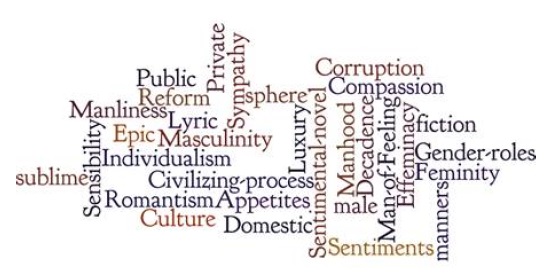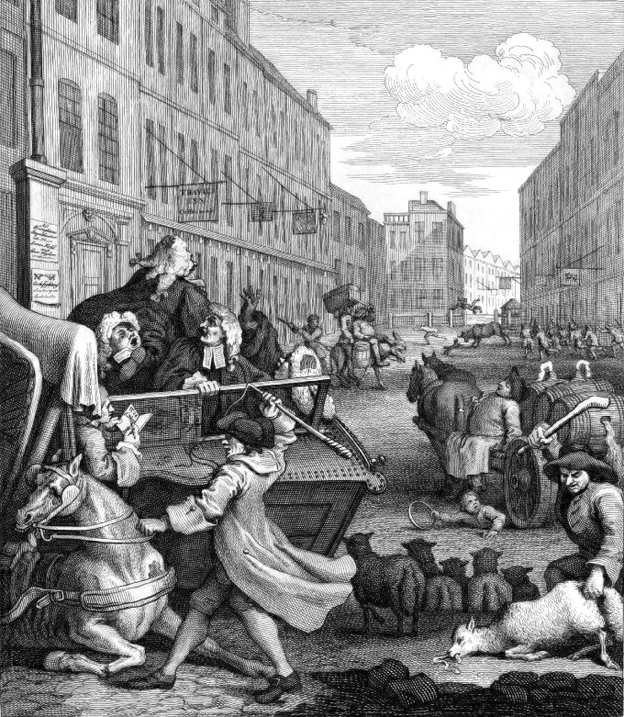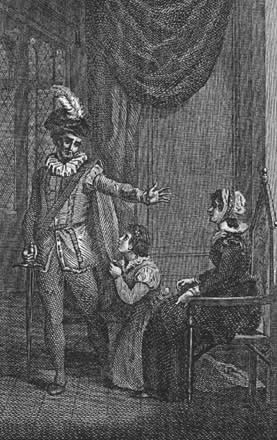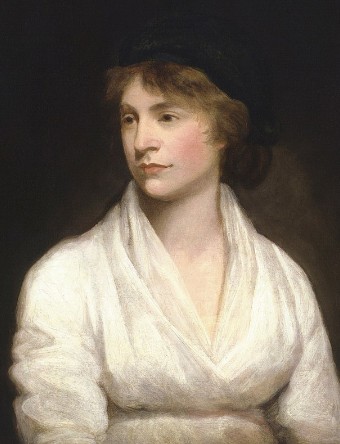In the Preface of the Lyrical Ballads (1798) seen as the manifesto of Romanticism, Wordsworth made this momentous and pivotal statement that “all good poetry is the spontaneous overflowing of powerful feelings”. He goes on to emphasize feelings over action (“it is this, that the feeling therein developed gives importance to the action and situation, and not the action and situation to the feeling”). Before him but sadly not as famous, Mary Wollstonecraft -despite her previous critic of sensibility, see below- anticipated his ideas and mentionned in her essay « On artificial Taste » « the transcript of immediate sensations, in all their native wildness and simplicity » by “the poet, the man of strong feelings” (The Monthly Magazine, 3, 1797).
This focus on personal emotions and passions appeared quite radical at the time. Indeed so far the literary canon had been dominated by Augustan epics, tragedies and decorum (emphasis on reason and order) at the top of the hierarchy. The lyric was then regarded as a minor kind while sentimental fictions -especially by women writers- were mocked and debased. Nonetheless it became a major and essential form for the Romantics. This turning point did not come out of nowhere though. English literature did not move from the Augustans straight to the Romantics even though the transitioning step(s) is (are) often missing in most English academic/school textbooks… Indeed, in addition of the (French and American) revolutions, it is the result of a combination of social and economic factors that came to be known as The Age of Sensibility (according to the phrase coined by the literary critic Northrop Frye in 1956 and sometimes also called a bit vaguely and derogatorily « pre-romanticism »), during the second half of the 18th century. “Sensibility grounds Romanticism which belongs to the long age of sensibility”, reminds rightlty Christophe Nagle, despite the denial of the Romantics themselves who looked down on their predecessors (and inspirators!) as « vain » and guilty of « solipsistic self-consciousness » (Todd 13).
This evolution led, among others, to a redefinition of “manhood”. Indeed a new approach to masculinity emerged in 18th century novels, in opposition to coarser, less civilized and more brutal figures of warriors along with a revised conception of God.
The latter eighteenth century also witnessed a transformation of the « Man of Reason » as Genevieve Lloyd calls him in her eponymous essay, embodying the ideal of rationality promoted by 17th century philosophers, into the « Man of Feeling« . Mary Wollstonecraft records this evolution (and crisis) by juggling multiple designations in her Vindication of the Rights of Women (1792) : the « man of sense and feeling » (to refer to Rousseau), « sensible men« , “men of lively sensibility”, « reasonable men » or the dangerous « men of wit and fancy » for « rakes ».
The proponents of this new man advocated in particular new “social affections” encompassing sympathy, compassion, benevolence, humanity, and pity – against selfishness. Yet, this shift triggered conflicts over definitions of genders, a (timeless) thorny question.

I/ The Man of Feeling: A New « Softened » Manhood
The man of Feeling represents a “genuinely moral” movement, and an “upsurge of new attitudes and emotions” as the English historian Lawrence Stone wrote it. At the heart of this new culture of sensibility lies the reformation of manners aiming notably at making men conscious of women’s minds, wishes, interests, and feelings. The sentimentalists’ targets were men who were “hard”, “hard-hearted”, and “unfeeling” to women. Thus, the triumph of sentiment was the outcome of this revolution in
manners.
a/The Reformation of Male Manners in 18th-century England
It started during the late years of the 17th century and took up the cause of Puritans to regulate improper behaviours (“the expression of carnal worldly appetites”). Sentimentalists defined unacceptable masculinity through the imposition of “standards of shame, delicacy, and self-control” over the period from the 16th through the
19th centuries. This led to a discipline of “appetites” and manners of the “drink-and-betting” based male culture, which also very violent (including a great deal of cruelty to animals like « bear-baiting » or « cock-fighting ») (“Norbert Elias, The civilization process” cited by Barker-Benfield, p.78 Chapt 2).
b/The Religious Influence on the Shaping of the Man of Feeling in 18th-century England
18th century religion played an important role in the change of the public male manners through the inculcation of “the Protestant ethic”. The shift in the perception of God relation to humans turns out to be particularly significant. After a century-long dispute, instead of a hard-hearted, arbitrary cruel tyrant, God took on a
more sympathetic figure, prompted by feelings and benevolence. This brings about a new “sentimental piety” rendered by a sentimental literature enjoying the “luxury of grief” or “indulging one’s feelings”. The new male ideal was then identified with Christian piety (cf. The Christian hero by Richard Steele 1712), endowed
with an “innate human goodness” and a « strong moral sense” according to the father of sentimental ethics, the Earl of Shaftesbury (in Characteristics of Men, Manners, Opinions, Times, 1711). In addition, the idealization in sentimental fictions of men capable of virtuous suffering can be connected to the “feminized”
figure of Christ.

William Hogart. The second stage of cruelty. Drawing. 1751. In courtesy of the Print
collection. Lewis Walpole Library, Yale University.
This engraving exemplifies the violence suffered by animals and metaphorically that of
women traditionally associated with animals, and often (legally) battered. From the writers Margaret Cavendish through Frances Power Cobbe, women equated men’s treatment of animals with their treatment of women.
c/A New Benevolent and Sympathetic Man
This evolution also impacted directly relations between men and women as Evangelism’s campaigns (along with the humanitarian reform) worked to repress men’s violence (“warrior society”). The man of feeling rejected brutal treatment of women and respected them. Physical harassment of women in public was now no longer acceptable. The masculine ideal was expected to care about women’s feelings. This stance is shown in The Mysteries of Udolpho by Ann Radcliff (1794) as Valancourt shares Emily’s grief: “Valancourt understood her feelings and was silent”, and he weeps silently with her.

Illustration, The Mysteries of Udolpho, Vol. 3, p. 130 (London: Longman, Rees,
Orme, Brown and Green, 1830). Due to the redefinition of male sentimentality at the time, Radcliffe’s heroines had to combine traditional and new ideologies of gender. Women had to “be paragons of passive feminine virtue as well as exemplars of an older-styled masculinity” (Johnson, 97). This is noticed for instance in one of the farewell scenes between Emily and Valancourt, where Emily restrains her emotion while her beloved shows “somewhat more than female fortitude”.
Sentimental fictions’ softened male characters who became benevolent, compassionate, literate and humane. Sentimental heroes opposed gambling, oaths, drinking, idleness, cruelty to animals, and other elements of male popular culture. In other words the heroism of the heart was celebrated over the heroism of martial or political prowess (Henry Brooke). In 1773, Hume published “The Stoic” which set out the male ideal resulting from the process of refinement, where sensibility was likened to “humanity”. He modified the classical ideal of the stoic to achieve a new combination of toughness and tenderness. Hume, like Adam Smith and Shaftesbury valued “cultivated” and “civilized” societies, founded upon “humanity” in opposition to “savage” and “barbarian” societies. Moreover Smith emphasized that sensibility to the feelings of others was compatible with the manhood of self-command.
c/The Economic Influence on the Shaping of the Man of Feeling in 18th century England
The British commercial expansion and the rise of capitalism (“monied interest”) contribute to alter the notion of manhood as well. The physical conflict in relations between men was substituted by reserve and mutual consideration. However it also caused many fears and tensions (as the anxiety over effeminacy).
II/ The Fear of Effemincacy: Confusion of Genders and Tensions
This new praise of a sensitive man did not go without many tensions, ambivalence, and words of caution. Writers fear mainly that an “oversentized” man could entail a “loss of masculinity” and ultimately an “effeminacy”, the worst of the dangers! Indeed men should not be identified with women. If extreme sensibility was acceptable and even encouraged for women, it was still seen as a “weakness” and “cowardice” in men. The tension between the prized refinement in men and the wish to reconcile it with manliness permeated the 18th century novel.
a/Sense and Sensibility
Thus we can find many warnings throughout literary works. For instance, tenderness “if taken too far could be subversive” pointed out Shaftesbury who called for a reasonable ecstasy and transport. According to him, the virtuous mind do not depend on “sense only” – on pain of anarchy- but also cultivates reason (Barker-Benfield).
This latter along with education were regarded as important contributors to masculinity. Women were naturally soft and without reason, men naturally harder, rough and reasonable (strong reason). Too much goodness or effeminacy were also believed to unfit a man to deal with poverty or adversity.
b/Luxury and Decadence
Another great concern was that of the “degeneracy” and “enervation” of the “business man” brought about by the “monied interest” and the decline of the citizensoldier. Indeed, to pursue passions (luxury, fortune) and to be victimized by them was traditionally seen as female. A common analogy was often held up to support this view: the historical lesson of the decadence and fall of Rome, from virtuous republic to luxurious empire (tyranny imperial ambition, corruption of courtly manners, and the degenerative effects of luxury, all leading ultimately to effeminacy). The rich are “weak and childlike” accused Thomas Day (Barker-Benfield).
c/ Hardness vs. Softness
In his work (“The history of Sandford and Merton” 1783-9), despite his emphasis on a “good heart”, Day repeatedly contrasted the hardihood of males brought up under Spartan circumstances with the enervation of those reared in luxury, under Rousseau’s influence (The Confessions 1781-1788). In the late 18th century, reformers started to intervene in childrearing in order to make little boys tougher. Likewise, Thomas Day believed that boys should be educated to be more toughminded, for the defense of liberty and male bravery. “Indulgence in sorrow renders them unfit for duties”, he claimed. Day illustrates a century of ambivalence that has tipped toward a concern with the dangers of “effeminacy”. There was a widespread reaction and anxiety to the triumph of sensibility, which reached a climax at the end of the 1770s (Barker-Benfield). In 1771, MacKenzie published “The Man of Feeling” in which he shows a male whose feelings were so important that he was rendered « unfit for the business of life’. In “The Mirror” (June 19 1779) the author praised his own prose for its “power of awakening the finer feelings, which so remarkably distinguish the composition of a gentleman”. Some read it like the embodiment of Smith’s formula that “delicate sensibility” could destroy “masculine firmness of character”. However MacKenzie was misread according to his best friend Scott who contended that “his hero’s extreme gentleness of temper” was not at all at the expense of his manhood, and not allied to effeminacy.
The Attacks on Sensibility by Wollstonecraft
To conclude, I just wanted to mention the critique on sensibility by women especially the debate that took place between Mary Wollstonecraft and Anna Barbauld. At this period, sensibility came to be epitomized by women idolized as “angel pureness” against licentious and rude males. They were also ascribed a civilizing role. However in her Vindication of the Rights of Woman Wollstonecraft who described herself as a “strange compound of weakness and resolution” (in one of her letters to J.Johnson) rose against this deification of sensibility in women. Yet she mainly targets what she defines the « artful », « affected », « false », « artificial » and “overstrained » sensibility (that is « artificiality », a keyword in her thinking that would give his title to her main aesthetic statement « On Artificial Taste »), an exaggerated male cultural construction of « sickly » or « unatural delicacy » and « overwrought emotions ». On the other hand, she values what she terms « the real beauty of sensibility » i.e « artless » and « natural affections ». This distinction between those two types of sensibility is central in Wollstonecraft’s line of reasoning. It is unfortunately often overlooked or mistakingly interpreted as a downright rejection…

 She believed women should also exercise reason through a solid education and a well-developed knowledge: “(…)virtue says reason must be acquired by rough toils, and useful struggles with wordly cares”, she wrote in reaction to Barbauld’s poem, “To a Lady With Some Painted Flowers”, in which a lady was compared to flowers “sweet and delicate”. In her “Rights of woman” in 1792, as a reply to Wollstonecraft, Barbauld declared that woman herself is “the courted idol of mankind”. She believed that woman’s weapon in this resumption of right were “soft melting tones”, “blushes and tears”. In her chapter 2 “The Prevailing Opinion of a Sexual Character Discussed” in A Vindication of the Rights of Woman, Mary Wollstonecraft also criticized the treatise Father’s Legacy to his Daughters (1761) by Dr Gregory, a Scottish physician who recommended to deny education to women (as detrimental to marriage). She particularly took issue with his praise of sensibility (and “modesty”) he calls “the power of women”, designed to “soften men’s hearts and polish their manners”. She contended that this emphasis on sentiment at the expense of reason, instead of helping women participate in society, harmed their development and created dependence on men. The softer emotions and the desire for beauty, elegance and approval rendered women “servile” just like in a courtly dependence of a “tyrannical ruler” (Steiner). Finally Jane Austen decided to satirize it by parodying emotional excesses and mocking sensibility cliches in her famous novel “Sense and Sensibility”. She showed how bad moral conduct, selfishness, and hypocrisy could be concealed behind the veneer of sensibility (Byrne). [Alexandra Galakof]
She believed women should also exercise reason through a solid education and a well-developed knowledge: “(…)virtue says reason must be acquired by rough toils, and useful struggles with wordly cares”, she wrote in reaction to Barbauld’s poem, “To a Lady With Some Painted Flowers”, in which a lady was compared to flowers “sweet and delicate”. In her “Rights of woman” in 1792, as a reply to Wollstonecraft, Barbauld declared that woman herself is “the courted idol of mankind”. She believed that woman’s weapon in this resumption of right were “soft melting tones”, “blushes and tears”. In her chapter 2 “The Prevailing Opinion of a Sexual Character Discussed” in A Vindication of the Rights of Woman, Mary Wollstonecraft also criticized the treatise Father’s Legacy to his Daughters (1761) by Dr Gregory, a Scottish physician who recommended to deny education to women (as detrimental to marriage). She particularly took issue with his praise of sensibility (and “modesty”) he calls “the power of women”, designed to “soften men’s hearts and polish their manners”. She contended that this emphasis on sentiment at the expense of reason, instead of helping women participate in society, harmed their development and created dependence on men. The softer emotions and the desire for beauty, elegance and approval rendered women “servile” just like in a courtly dependence of a “tyrannical ruler” (Steiner). Finally Jane Austen decided to satirize it by parodying emotional excesses and mocking sensibility cliches in her famous novel “Sense and Sensibility”. She showed how bad moral conduct, selfishness, and hypocrisy could be concealed behind the veneer of sensibility (Byrne). [Alexandra Galakof]
Sources and Works Cited :
Barker-Benfield G. J. The Culture of Sensibility – Sex & Society in Eighteenth-Century Britain. 1996. University of Chicago Press.
Byrne Paula. « Jane Austen and Satire ». The Oxanian Review. 31 March,2014 • Issue 24.6. Web. 05 Mar. 2015
Johnson, Claudia L. “The Sex of Suffering: The Mysteries of Udolpho.”Equivocal Beings Politics, Gender, and Sentimentality in the 1790s: Wollstonecraft, Radcliffe, Burney, Austen. Chicago: University of Chicago Press, 1995. 95-116. Print.
Nagle Christophe. Sexuality and the Culture of Sensibility in the British Romantic Era. New York: Palgrave Macmillan, 2007. Print.
Steiner Enit Karafili. Called to Civil Existence: Mary Wollstonecraft’s: A Vindication of The Rights of Woman. 2013: Rodopi. Dialogue (Book 17). Print.
Introduction “The Romantic period”. The Norton Anthology of British Literature, Volumes D and E, 9th edition. Ed. Stephen Greenblatt. New York: Norton, 2012. 13. Print.
Todd, Janet. Sensibility, An Introduction. London;New York: Methuen, 1986. Print
Wollstonecraft, Mary. « A vindication of the Rights of Women ».
Wordsworth, William. « Preface to Lyrical Ballads ». The Norton Anthology of British Literature, Volumes D and E, 9th edition. Ed. Stephen Greenblatt. New York: Norton, 2012. 292-305. Print.













Derniers commentaires